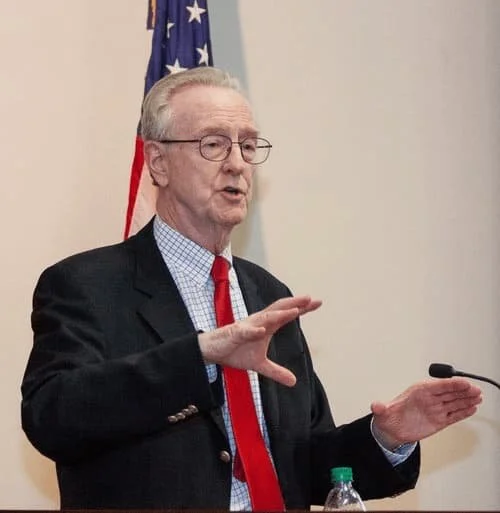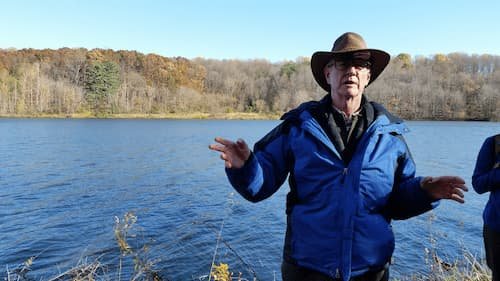Scott Fosler - An appreciation
“Like life, liberty and democracy itself, clean water is not something we should ever take for granted.” Scott Fosler presentation at 2017 Water Forum, Rockville MD.
With sadness, we share the news that our friend and founding board member Scott Fosler passed away, along with this appreciation of the critical role he played in the protection of Ten Mile Creek. Just within Montgomery County, Scott also served on the board of the Montgomery Countryside Alliance, as board president of the Audubon Naturalist Society, as vice chair of the Montgomery County Ad Hoc Agricultural Policy Working Group, as president of the Metropolitan Washington Council of Governments, and as mayor of the Town of Chevy Chase. He served two terms on the Montgomery County Council. He had additional notable roles outside the County.
Scott was instrumental in the creation of the Little Seneca Reservoir as part of an approach to insuring the regional water supply that relies on just two-reservoirs, as an alternative to 16 dams and reservoirs throughout the Potomac basin, which had been proposed by the US Army Corps of Engineers in the Northeast Water Supply (NEWS) study. That study was conducted in response to a projection that growth in water demand would exceed supply to recommend a plan for assuring the region's water supply for the next 50 years. It was followed by the record drought of 1966 and 36 instances in the '70s when water withdrawals exceeded the 1966 minimum flow, as shown in this timeline published by ICPRB.
As Scott explained in a presentation he gave in 2017, this simpler and more cost-effective 2-reservoir solution would only work if the region's water utilities would agree on a common set of rules for water withdrawals. The first step was the signing of the Low Flow Allocation Agreement in 1978. As then President of the Montgomery County Council, Scott worked in collaboration with then WSSC General Manager Robert S. McGarray to craft an agreement and reach out to their counterparts in other Washington Metropolitan area local governments and utilities who became parties to the Water Supply Coordination Agreement of 1982, which established rules for releasing water from the reservoirs to augment low flows. The Little Seneca Reservoir was completed in 1983, and water has since been released to augment low flows in 1999, 2002, and 2010. (ICPRB gives more information on the history of the cooperative management of the Washington Metropolitan Area Water Supply.)
In more recent years Scott became a champion for protecting Ten Mile Creek and played a critical role in the 2013-2014 campaign to save it, always pointing out that a clean source of water is even more critical during low flows, which is when pollutants become more concentrated, and it becomes more difficult to treat and safely drink it. On September 11, 2013 he participated in a tour of Ten Mile Creek and the Reservoir for then County Executive Ike Leggett and other County officials. In response to a request from Ike Leggett, he then sent a memo outlining a study of development impacts on the Little Seneca Reservoir. A key deficiency he proposed that the study address is that the Clarksburg corridor city in the headwaters of Ten Mile Creek, and the Little Seneca Reservoir were placed in separate Master Plan areas. As a consequence, the impacts of development in Clarksburg on the reservoir, and the cumulative impacts, were never systematically assessed. He also gave testimony to the Council. Although that proposed study was never conducted, Scott's advocacy played a critical role in Leggett's decision to forgo development on County properties in the watershed.
The Council was also influenced by an Op-Ed in the Washington Post that Scott co-authored with John Menke, former Council Member and Director of the County Department of Environmental Protection, and Royce Hanson, former Chair of the Planning Board, "Montgomery County rolls the dice with the region's water system". At a subsequent committee work session, then Councilmember Nancy Floreen asked "Are we really rolling the dice?", “Would the proposed limited amendment to the Master Plan affect drinking water?” Representatives from WSSC and DEP both said no - with DEP adding the caveat that this is because water quality in the reservoir meets water quality standards, for now, and Ten Mile Creek would not pollute it any more than its other two tributaries. The DEP representative also added that protecting Ten Mile Creek would help protect the reservoir. The Council also considered whether to conduct the study Scott had proposed, prior to or after their decision. They chose to not delay their decision in order to conduct the study, and did not see a reason to conduct it after the decision. But with development imminent that is in clear violation of Ten Mile Creek Limited Amendment to the Master Plan adopted by the Council in 2014, such a study is more necessary now than ever.
Scott Fosler gives the history of the Little Seneca Reservoir during a 2014 hike with Friends of Ten Mile Creek.
As an active board member of Friends of Ten Mile Creek until stepping into an advisory role last summer due to illness, Scott continued to present the history of the Little Seneca Reservoir, stressing the importance of Ten Mile Creek - on group hikes, at a 2017 Water Forum, at annual gatherings, and most recently in written testimony to the Planning Board regarding proposed development in the watershed. In this last piece, he expressed increasing concern with how current challenges to our water supply will be further exacerbated by climate change. He has also been a continuous source of thoughtful advice to the organization as we consider next steps.
Scott has been an inspiration, a mentor, and a dear friend for so many of us. We will miss him terribly. May his memory be a blessing.


